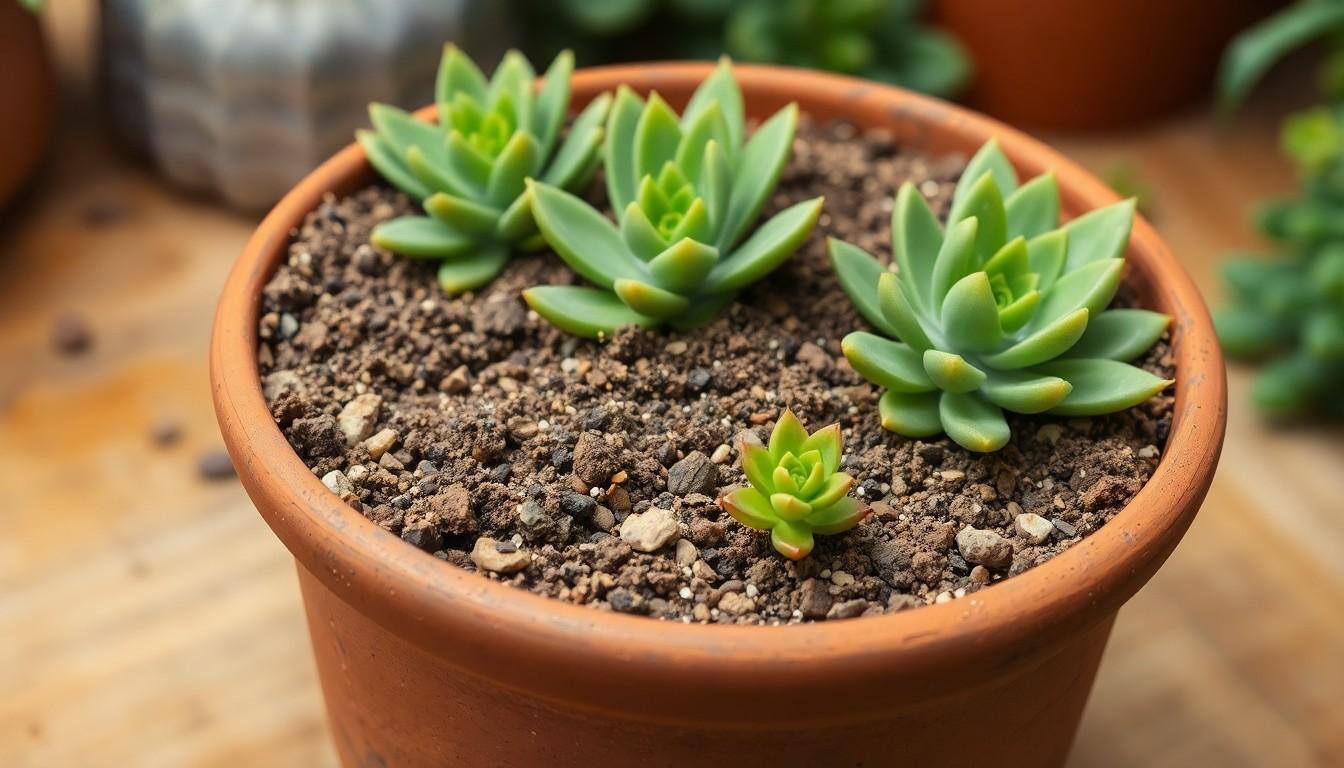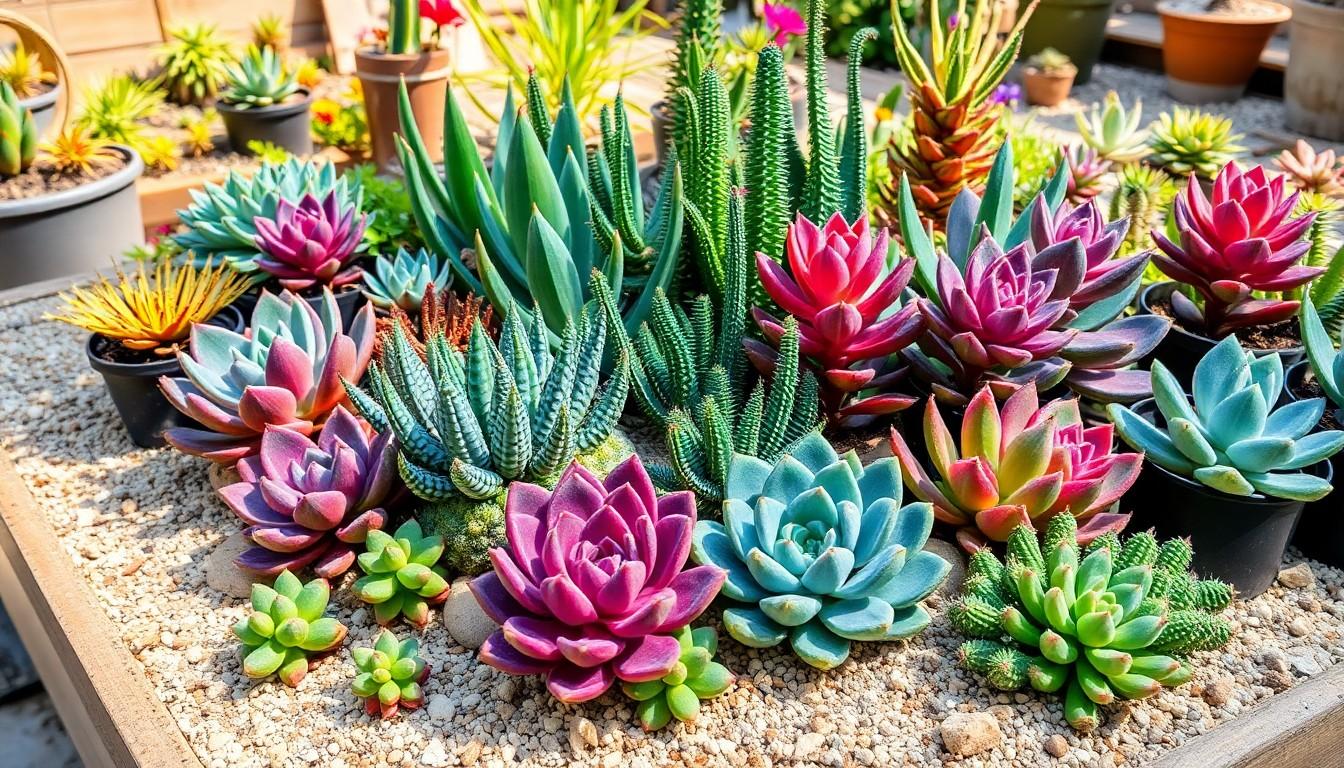When it comes to growing succulents, the secret’s in the soil. Picture this: your adorable little cactus is sitting in a soggy mess, contemplating its life choices. Not exactly the happy ending you want for your plant babies. Choosing the right soil can make all the difference between a thriving succulent and a sad little leaf drooping in defeat.
Importance Of Soil For Succulents
Soil plays a crucial role in the health and growth of succulents. Proper soil ensures efficient drainage, preventing root rot that often occurs with moisture retention. Many succulent species thrive in well-aerated mediums that mimic their natural habitats, which usually feature sandy or rocky substrates.
Utilizing the right soil composition supports nutrient access. Ingredients such as perlite, pumice, and coarse sand promote aeration while improving drainage. Healthy roots depend on a balanced environment where moisture is present without being excessive.
Inadequate soil leads to various issues, including drooping leaves and stunted growth. Succulents often display signs of distress when submerged in heavy, compact soil that traps water. Poor soil conditions also encourage fungal infections, further threatening plant health.
Access to essential nutrients, including phosphorus and potassium, becomes difficult in bad soil. Properly formulated succulent mixes contain these vital elements in appropriate ratios. Recognizing these requirements helps in selecting the best commercial soil or creating a tailored blend.
Ultimately, the right soil creates conditions where succulents can store water efficiently while also allowing for adequate air circulation. Understanding the importance of soil establishes a solid foundation for cultivating thriving succulents. Prioritizing soil quality not only supports root development but also enhances overall plant vitality and longevity.
Characteristics Of Ideal Succulent Soil

Ideal soil for succulents possesses distinct characteristics that promote healthy growth. Attention to drainage and aeration plays a significant role in achieving optimal conditions.
Drainage
Drainage is crucial for succulent health. Succulents thrive in soil that drains quickly, preventing water from pooling around roots. Overwatering leads to root rot, a common issue caused by poor drainage. Ingredients like coarse sand and pumice enhance drainage capabilities. They create pathways for excess water to escape, ensuring roots remain dry. A well-draining soil mixture allows for rapid absorption during watering, facilitating nutrient uptake. Ultimately, good drainage nurtures strong, resilient plants that flourish.
Aeration
Aeration is equally important for succulents. A well-aerated soil mix allows air to reach roots efficiently. Roots require oxygen for healthy growth, making proper airflow essential. Using light ingredients such as perlite enhances aeration. These materials create spaces in the soil, promoting root development and preventing compaction. Compacted soil restricts airflow, limiting nutrient access and leading to weakened plants. By prioritizing aeration in the soil mix, gardeners support vibrant, thriving succulents.
Types Of Soil For Succulents
Selecting the right soil mix is vital for healthy succulent growth. Various options exist that cater to these unique plants.
Commercially Available Soil Mixes
Commercial soil mixes specifically designed for succulents often include essential components like perlite, sand, and peat. Many brands offer convenient ready-to-use blends that ensure proper drainage and aeration. Using these mixes eliminates the need for additional amendments, saving time and effort. Some popular products are designed to mimic the natural desert habitat of succulents, promoting thriving growth. Identifying well-reviewed options before purchasing enhances the likelihood of successful plant care.
Homemade Soil Mixes
Creating a homemade soil mix allows for complete control over the components. A common recipe combines one part potting soil, one part coarse sand, and one part perlite or pumice. Adjusting these elements can tailor the mix to specific succulent needs. Homemade mixes often yield excellent drainage and aeration, critical for preventing root rot. Experimenting with various ratios also enables growers to discover what works best for their plants, enhancing their care routine.
Factors To Consider When Choosing Soil
Selecting the right soil for succulents involves multiple factors. Evaluating plant type and environmental conditions ensures the best growth.
Plant Type
Different succulent species have unique soil requirements. Cacti thrive in extremely well-draining, gritty mediums, while other succulents may prefer a more balanced mix. Consider the specific varieties being grown. For instance, graptoveria prefers soil that retains some moisture, unlike agave which needs a fast-draining mix. Researching each type’s native habitat informs soil choices. Those from arid regions benefit from sandy compositions, while subtropical species often thrive in loamier soils. Mixing components like perlite or coarse sand modifies texture, accommodating plant needs.
Environmental Conditions
Environmental conditions play a significant role in soil selection. Indoor succulents may require different moisture retention compared to outdoor ones. Locations with high humidity should have drier soil to prevent root issues. Exposure to sunlight can also influence moisture levels, making well-draining soil vital. Changing seasons impact the soil needs of succulents, particularly during winter when light decreases. Consistent monitoring ensures that the soil maintains optimal drainage and aeration. Variations in temperature also affect moisture levels, altering feeding habits over time. Adapting soil to these conditions enhances the overall health and growth of succulents.
Conclusion
Choosing the right soil for succulents is vital for their health and growth. A well-draining and aerated mix creates an ideal environment for these resilient plants. Whether opting for commercial blends or crafting a homemade mixture, attention to the specific needs of each succulent species can make a significant difference.
Monitoring environmental conditions and adjusting soil components as needed ensures that succulents thrive. By prioritizing proper soil characteristics, growers can enjoy vibrant and healthy plants that flourish for years to come.

